I came upon this site and found this very interesting post related to an inkjet printer that has been modified or rather the inks were replaced to be able to create such wonderful origami art works. If you haven't heard it last year about an inkjet printer that can create self-folding origami, here's a brief info for you. The printer was called Hydro-Fold, there's nothing much special with this machine and in fact it's about a hundred similar to any conventional inkjet printers in its time. The only difference it caters is the special ink mixture inside its cartridges, which makes it possible for the printer to create self-folding origami designs. Though you can't expect it to churn out paper doves and swans, the output was not really as intricate as real origami works but they're somewhat similar. First the user creates a design or a pattern which primarily composes lines and nothing but lines. Then after making the pattern, user send it to the printer and wait for it to spit out the print job. Once the print is done, a matter of seconds will be required for the printout to fold by itself. Contorting its own along with the printed lines on the sheet. So basically instead of you manually folding the paper, the machine puts up some magic on the sheet and let it do the rest. See the images I've provided above to learn exactly what the Hydro-Fold can do with a simple sheet of paper.
Aside from lines, grids and shapes can be printed as well using the printer and its specific ink. By replacing the regular ink with a special mixture of ink and water, plus exploring the properties of paper materials, Christophe Guberan found out that his own specific ink mixture may bend the paper's structures. Guberan was a third-year student of Product Design at the ECAL by the time he developed the Hydro-Fold printer, such a naive guy.
Again let me remind you that this printer can't make intricately folded origami designs for you like a boat or an airplane. Unless you developed a printer that has its own hands to fold it exactly the way a skilled guy makes an origami. Just check out the provided images and see what other patterns you can do and print with it. I actually find it useful for making lamp shade covers or something like that.
See how inks can be used for such different applications. With just the right approach and idea you may developed your very own special printer that can be used for such purposes other than printing text and files usually. Just like with the use of eco-friendly toner cartridges and ink cartridges filled with none earth-damaging substances. Through using these consumables, we may create a greener and more environment friendly printouts that may help on preserving natural resources and protecting our planet.
With the effort to bring forth a new paperless office printing system, Toshiba introduced an essentially new kind of MFP printer, it uses laser technology hence it requires toners to produce printouts. Unlike any other lasers that works with the typical toners we've been used to, Toshiba's e-STUDIO 306LP/RD30 printer can create prints through a special toner that can be erased. It is a system though, the printer is paired with a unique device which they preferred to be called as the "Eraser". Once a printout produced from the RD30 printer has no use, erasing the print from the paper can be done by feeding it to the Eraser, which will then erase the prior document. It's not actually much of a task to do, since the benefit you'll get from it is much more worth it. Based on a recent release, paper sheets can be reused for as much as five times the regular printing. One of the key features of the Eraser is that it can detect a page that has been erased up to its maximum limit, thus separating it from the others and sending it to a bin. Additionally, if you have a FriXion pen from Pilot, or if you don't know what it is, well it's the pen version of this technology. The FriXion ballpoint pen has thermo-sensitive gel ink which can also be erased repeatedly without damaging the paper. Say, you have a printout from the e-STUDIO 306LP/RD30 printer and you want to put a specially hand written note on it, basically that's possible since the Eraser can also remove the ink from a FriXion pen.
According to British Standards Institute, a globally known national standard organization, about 57% of carbon dioxide (CO2) emmision has been greatly reduced. Plus it generally minimize paper usage by up to five times.The toner present in its cartridges is neither black nor color, it is actually distinguished as blue. It performs and deliver outputs in a similar manner, except that the printed text or images can be erased by applying heat. In any case you need to keep a copy of the file from the sheet before you erase it, the device can be configured to scan the existing print from a page and save it to an archive location before running through the process.It will certainly reduce the office's carbon footprint emission , paper waste, expense, and most of all, it teaches any working environment to become more environmentally responsible. Well, the system is not yet available to the market and is expected to be released before the end of this year. So for the mean time, to help you make a greener way of printing, consider using recycled toner cartridges and ink cartridges with your printer to help save the environment. Also, you'll not only contribute to the sustainability, but you also get to save more from using eco-friendly printer consumables and supplies.
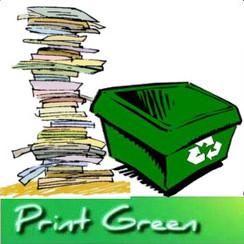 Million tons of paper waste are accumulated annually in the U.S. alone, then what more if we add up the waste from other countries around the world. No one should say that they have no idea on how should they properly managed waste or limit their consumption to reduce their generated waste. Cause as far as today's level of media and technology, we are well informed about such ways and acts that may help us improve our daily living in terms of reducing waste. Saving paper products and materials is not a very hard task, even kids can do it while having fun, it's just a matter of how you imply its worth. Positive results are driven by positive actions, and remember this part of song by the iconic Michael Jackson, "if you wanna make the world a better place, take a look at yourself and make a change". Start doing small things, like changing the way you usually print, it's not easy to change what you've been accustomed to especially if you make it a habit, but still you have to change if it's for the best. Before hitting the print button and sending your file to the print queue, check your file, are there more spaces where you can fit in more into the page, or see if the formatting is efficient both to the printer and paper you'll use. Unless it's a report that requires double spacing or any specific format. See if you can still reduce the font-size to a smaller font, as long as it's still readable, also avoid overly large font sizes and styles, this way you'll not only conserve paper sheets, but the inks/toners as well. Also, it's a good practice to use recycled printer papers and eco-friendly toner cartridges or ink cartridges when printing. The way to communicate with one another has rapidly change, although snail mails are still available. If you're message is not that important, then use a mobile phone, if you want to chat and open a messenger, if it's a bit important or private,then send it through email. Several options are available depending on the importance of what you're about to send. As much as you can eliminate printing emails, bills and all sorts of printables, then do so. Learn to recycle, and if you're not capable of doing such thing which I hardly doubt, then consider participating to any recycling organization in your community that accepts paper materials. To save more paper, we have to use them repeatedly and believe it or not there are hundreds of ways to reuse paper materials which you haven't thought of as possible. Just try to see this post about recycled paper materials turn back into wood or maybe the brief history and facts about paper will guide you on determining how can you make use of paper products efficiently.
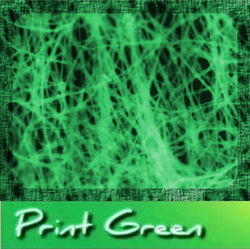 How broad is your knowledge about paper? Do you even know that its name was derive in two different words which is papyrus and papuros? If both of your answers are no, then spend a minute of your time reading this post regarding the things you might want to know about papers. First of all, the term papyrus is a Latin word, derived from the Greek word papuros, is a paper-like material which was first used in Egypt and Southern Sudan. It was extracted from a plant called Cyperus Papyrus in Nile delta. Back in millions of years ago, BCE, the Egyptians were able to utilize it as a writing material where ancient archaeological inscriptions were inscribed in hieroglyphic forms. It was the only material they had that time for writing purposes, however, it was too fragile and more prone to damage due to moisture and dryness, even the texture of it was somewhat irregular for legible writing. Then here comes the innovation, during the early 2nd Century AD, Cai Lun or Ts'ai Lun developed the pulp paper-making process. They cooked wooden fibres and mixed it with a slurry, then poured onto a cloth screen. China used paper as a substitute for silk, hence they were able to export silk instead. Since then, paper spread from China through the Middle East, then by the 13th century it hit the Medieval Europe where the very first paper-mills were built and powered by hydro-electricity. Several improvements and developments run in the history of paper making. One of which is the wood-fiber-pulping method which was developed in 1844 by two Canadian inventors namely Charles Fenerty and German F.G. The pulp paper-making method has two different methods : - Chemical Pulping - which consists of Kraft Process, Sulfite Process and Soda Process.
- Mechanical Pulping - which has two major process, the Thermo Mechanical Process and Groundwood Process.
Aside from the aforementioned methods, have you heard of the the process called " Deinking" or Deinked Pulping? It is simply one of the familiar terms we heard when it comes to preserving paper materials, which is Paper Recycling. Based from the name itself, "de" is a prefix which means to separate or remove, hence Deinking is simply removing the ink from the paper pulps.Generally speaking, recycled paper materials are either of the same quality as a new one, or may offer a bit lower than a manufactured paper out of new wood pulps. However, it's not actually a big deal to consider, especially if you're aiming to reduce paper waste and conserve natural resources particularly the trees. Besides, recycled papers nowadays are mostly compatible for printing purposes as well, just like using eco-friendly toner cartridges and ink cartridges.
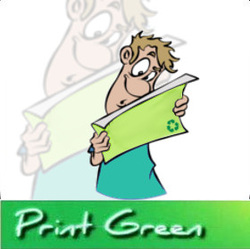 To set the record straight about what's the real deal between the print industry and the environment, how printing affects the ecological system, as well as the environmental impacts of every print we made. Here are the revealing facts that we should know before you skeptically accuse the value of printing. Many companies, not only the manufacturers in the Print Industry, are relying on printing technology. Indeed, there are negative impacts that had brought the environment to a not so well state due to improper printing practices, but it shouldn't always be the one to blame. Let's start with one of it's commonly consumed material, which is paper. People have this common notion that using paper materials kill trees, I give it a check, but trees are renewable, thus it can be replaced. For a fact, in the United States alone, they managed to increase their trees population by up to 20% in comparison to the 1st Earth Day celebration way back 40 years ago ( AF&PA). Private land owners in U.S. are planting trees everyday, 4 times the number of trees they harvest daily, and still continue to keep their land for forestry. The bottom line here is that, if you keep on wasting or using paper products, then might as well double or triple your effort on giving back what you got, plant trees more than what you consumed. E-Books are very common nowadays which perhaps affects the industry of book publishing. Books are produced from paper materials and printing process, and if you think you're helping the environment by becoming an E-Reader, here's what you need to know. Paper productions require about 50-60% of energy which comes from renewable resources, take note of the word "renewable". Now with those E-Books, how are you supposed to access and read those? Through tablets, smartphones, mobile devices, etc., whatever you call it, still they all generally address as electronic wastes. Another question, how are you supposed to use an e-book reader unless it has a charge right? Do you think the power or energy that your devices consumed can be renewed, even so, the health effects and environmental effects of using such devices are more adverse than reading a book. Electronic waste or what you call high-end devices, are made of plastics, metals, and a combination of minerals that are non-renewable, and can only be acquired through mining. Furthermore, most of these devices have only 60-80% of their components which can be recycled, the rest are dismantled, disposed and end up as land fillers. Whereas the supplies and consumables of a printer has a better rate of recyclability. Printer cartridges for example can be recycled for more than 4-5 times or more, these are called recycled toner cartridges and ink cartridges. They produce less carbon footprint compared to several electronic devices that unsafely and uncontrollably emitting carbon footprints which definitely harm the environment.
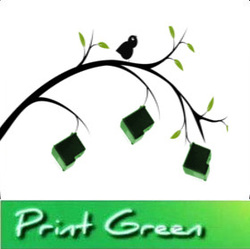 When it comes to printing one must be ready with the expected and unexpected expenses that may arise along with maintaining a printer. At first you might not be able to notice this but actually purchasing such device will not count as the beginning, but rather by the time you have to get a replacement once the initial supplies run empty. A customer who owns a printer for such a long time is practically aware of how expensive print consumables can be. In fact, they said that if try to pile or sum up all the receipts and cost you spent over a year from buying cartridges, you might just drop your jaw. That's where the idea came from, that -- you would rather get a new printer that comes with a set of free cartridges instead of purchasing a set of replacements. One of the simplest and ideal way to considerably make the expense lower is to start using recycled printer supplies. These products are definitely not associated to those substandard consumables. Compatible cartridges are also different from recycled supplies, nor it's not even related to refilled cartridges, not at all. Recycled printer cartridges are made from used or empty ink and toner consumables which are basically reused to manufacture new original supplies. Once a cartridge runs empty on ink or toner, it's just the consumable inside it that was spent. While the components are still reusable and in good working conditions, manufacturers along with their recycling programs accept returned supplies such as cartridges and even old printers. Some organizations would be more glad to give rewards to anyone who participate in their programs by simply returning their printer's spent cartridges or again even the machine itself once it reaches it's end-of-life. Post-consumer cartridges are not the only ones that undergo recycling process, paper products particularly the supplies we used for printing purposes can also be recycled. Whether you're using a printer in the office or at home, wouldn't it be more convenient in your part if your device is using cost-efficient and environment friendly recycled toner cartridges or ink cartridges, plus those recycled paper materials?Again, it's not hard to switch to green printing practices and it wouldn't break the bank or cost you more, than keep on using highly expensive replacements. The market has a lot to offer, but remember although there's an abundant of supplies to choose from, cheaper doesn't always mean ideal and you have to learn how to dig inside a mixed bag. It's either you fall into the right retailer or end up wasting your money from fraud manufacturers.
Paper materials or paper products whatever you call it, they're basically made from wood. Albeit there are many ways to recycle them, there ain't much ways to bring them back to their original form or state. But with Andrej Malinin, a Swedish clever designer who used newspapers and colorful pages of paper waste for her recycling project which aims to create a compostable furniture as durable as a real wood. The output was superbly unique, sturdy and hard as wood with texture and appearance that resembles lumber or timber. Malinin just basically glued thousands of paper layers using a water-based adhesive, and the output was incredibly awesome that it actually mimic a wood. His wonderful creation was entitled "Back To Wood" by the designer himself which definitely implies the true interpretation of Malinin's recycling project. Come to think of it, if it's really as strong and durable as what they claimed, that it can withstand pressure and several factors that a real wood can endure. Then wouldn't it be nice to create your own table or rack by recycling tons of paper materials which eventually will turn as waste? Of course there are considerations and certain limits to which you should be mindful given that it's not really made out of wood. Perhaps like using it for your table top decorations or flower vases. Another good idea is to create a computer rack or a printer rack, where you can place your printing machine into a naive and environment friendly stand. Say, in the office, there are hundreds of paper waste or drafts or printouts that you can collect and recycle for this purpose. Why don't you make a framework, like I said for a printer equipment, since it's kind of light and small. Additionally, it's the printer that mostly generate paper waste in any office and businesses, hence it's ironic to use its waste for a good purpose. If being eco friendly really matters to you, plus, crafting and nifty recycling projects are just your stuffs, then it's worthy to try making your own version of Malinin's Back to Wood creation. Then another good suggestion you may consider is by using eco-friendly toner cartridges or ink cartridges with your printer, as well as recycled paper products when printing. You can cut down the bills and expenses accrued annually, and most importantly, save and protect the environment.
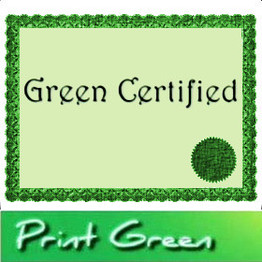 Are you familiar to some international standards and certifications a company or organization may received or have, to be claimed as environment friendly? These green credentials defines the effectiveness of their products as being environmentally oriented. If your printer or supplies either has one of the following or probably have a few of these, then you're more than lucky to print the eco-friendly way. A certificate that's based with the international standard, the ISO 14001 or ISO 14001 EMS (Environmental Management Standards) aids on reducing negative ecological impacts of various organizations and operations. There are laws and regulations related to environment preservation from which they must comply to improve and obtain the ISO 14001 Certificate. Being the most valued green certificate, money is not the only factor involved to achieve such credential, time and dedication must be invested as well. Another worthy and honored certification is the FSC ( Forest Stewardship Council ) is an independent organization that provides internationally recognized certification to companies that promote the same mission to responsibly protect the world's forestry. Printer manufacturers are not the only ones that can be certified by FSC, even paper manufacturers may obtain it. A certification system similar to FSC is the PEFC (Programme for the Endorsement of Forest Certification), the world's largest forest certification system. One of the forest certification standard that grants an eco-label to PEFC certified companies and organizations, which can be easily identified by most consumers. Do you know that Hewlett-Packard printing solutions and paper products are both FSC and PEFC certified? Aside from the Energy Star marks that you can find in every machines, HP oaths to reduce the impacts of their company on the environment particularly in the printing industry. Some recycled paper products may have less quality that is suitable for printing, however a paper product that has been FSC, SFI and PEFC certified ensures the best output while producing less environmental impacts to the environment. Companies and manufacturers that have satisfied the standards and requirements of these certifications and laws, have demonstrated a commendable and laudable effort on helping in the sustainability of our forestry around the world. Perhaps by now, you can at least conclude if your printing practices, as well as the machine and supplies you're using is truly environment friendly or not. Paper materials used for printing are available in recycled types, even the consumables that printer uses are recycled. Printer manufacturers are producing eco-friendly toner cartridges and ink cartridges to prolong sustainability, these products are also bounded by laws and quality test to reassure their customers about the quality and performance of their products.
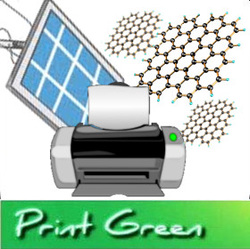 Inkjet printers are not just for conventional printing, and this has been proven years ago. From its basic function to print text, images and graphics either mono or color, it's main purpose evolve into something more unusual. Let's admit it, researchers and developers are really good at this, surprising us with their inventions and breakthrough that brought us to this new world. In the year of 2008, Konarka Technologies, developed a printable solar panel film which can be used for photovoltaic solar panels. With the use of an inkjet printer they were able to produce solar panels as thin as a plain paper sheet through common inkjet printing process. Konarka developers replaced the ink that we commonly used in our everyday printing needs, with solar cell materials, while the sheet from where these matters will be printed are not just a typical paper sheet but a special and flexible plastic substrate. It became a hit since printed solar cells are way cheaper than silicon panels, however the option to release it for the masses is not considered yet. Konarka's breakthrough was followed by another discovery from MIT Discoveries. Production and installation of solar panels are normally expensive, thus, once an alternative came into the consumer's view it will surely make a hype. That's what the MIT Researcher's figured out, a way from which solar cells can be printed onto paper materials using the printing process similar to an inkjet printer. The invention was called semiconductor-coated paper that features a carbon-based dyes that improved the solar cells efficiency by up to 2%. As the most recent update regarding the application of inkjet printing, Max Plank Institute Of Colloid and Interfaces in Potsdam-Golm had a group of researchers which was led by Cristina Giordano, that was able to utilized paper sheets to produce conductive structures. Again with the use of an inkjet printer, they made it successful to deposit catalyst on sheets of paper and by simply applying heat into the surface, it eventually turn into a graphite capable of conducting electricity.
Source : Inhabitat
"To fabricate their electronics, the Potsdam researchers converted the cellulose in paper into graphite by using an iron nitrate catalyst laid down by a commercial inkjet printer. After being heated to 800 degrees Celsius in a nitrogen atmosphere, the cellulose expelled water until all that was left was pure carbon. These areas become conductive, while the non-printed areas are less able to move electrons."
As it seems, inkjet printing technology can also be utilized in the field of carbon electronics. Although these inventions are not to be purposely commercialized, it's quite considerable since these breakthrough are still on their research phase. Ink cartridges on the other hand aren't left behind. Unlike with printer toner cartridges, aside from the fact that alternatives such eco-friendly toner cartridges are commonly available, breakthroughs aren't feasible yet. Whereas with inks, there were a few researches like solid inks and bio-based inks that may lead to such innovations where we could hope commercialization is not just an option.
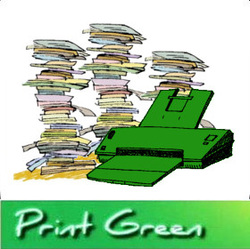 Do you want to save with your printer's mounting expenses? The fact that most manufacturers are selling highly expensive printing supplies, it can be hard to cut down the cost. In most cases, users opt to decrease their consumption of supplies and reduce their volume of printing just to at least moderate the generated expense. In our today's world, options are abundantly available, and we just need to consider trying them to find out how can they be useful for our problem. Quit asking if there's such a way to set yourself free from those pricey printer consumables. Indeed there's a way, and one good example to cite with are the replacement cartridges or the so called remanufactured cartridges. These consumables are made from OEM components of empty or used cartridges, hence they can still be tagged as original.Through using remanufactured toner cartridges and ink cartridges, you can greatly shrink your printer's recurrent expense by almost half of the previous months where you used OEMs. Remanufactured printer cartridges come with the word cheap or substandard. Yes these products are substantially cheap but they're not substandard. Fraud manufacturers are fishing for easy money, they're the ones responsible why people connotes the term 'substandard' when they heard of remanufactured cartridges. Many printers now support economy mode of printing, but how can this feature be useful to reduce overall expense? Let's say your printing drafts or test pages, you think it's efficient in your part to print in regular settings when you can use eco-mode? Basically, what it does is to prevent the printer from using excessive ink/toner with every print. Text output may somewhat fall into gray-scale quality but still readable, unless you need a hard copy for an important purpose just turn the eco-mode off. Another way to reduce printing cost particularly with the supplies, is by fitting two pages in a single sheet or try duplexing, a feature that allows printing on both sides of a page. First you make a cut on the expense or purchasing paper materials, second, you get to reserved more inks since printing two files in a single paper tend to shrink the output. As a rule of thumb, if you don't intend to use the printer for photo printing, graphics or high resolution prints, it is wise to have a laser printer instead. Laser toner cartridges have a considerably low cost-per-page, that's for original brands. What more if you try using the remans which are half the price cheaper compared to branded supplies.
|
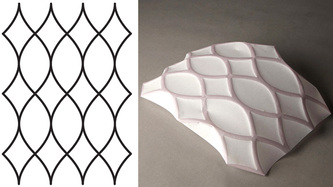
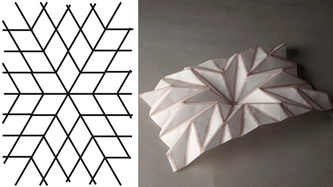







 RSS Feed
RSS Feed